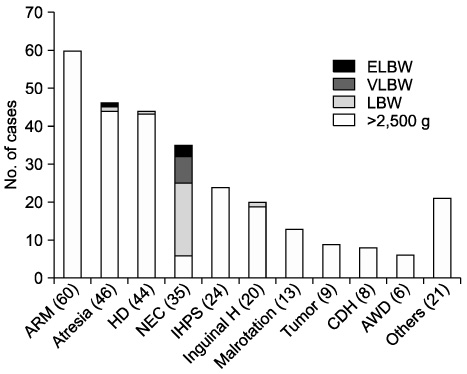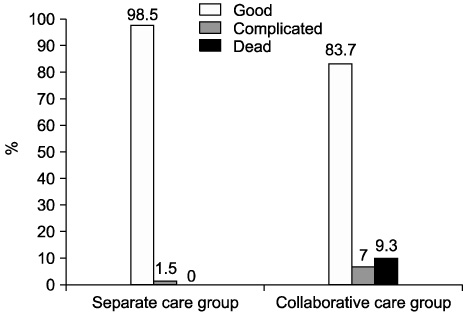J Korean Surg Soc.
2009 Dec;77(6):417-422. 10.4174/jkss.2009.77.6.417.
Analysis of Neonatal Surgery during a 5-year Period
- Affiliations
-
- 1Department of Pediatric Surgery, Pusan National University Children's Hospital, Busan, Korea. haeyoung@pusan.ac.kr
- 2Department of Surgery, Pusan National University Yangsan Hospital, Postgraduate School of Medicine, Pusan National University, Busan, Korea.
- KMID: 1464822
- DOI: http://doi.org/10.4174/jkss.2009.77.6.417
Abstract
- PURPOSE
In the field of pediatric surgery, neonatal surgery occupies a special portion and has clinical varieties. Recently many associated physicians, such as pediatric surgeons, neonatologists, anesthetists, pathologists and radiologists, work collaboratively for care. This study was designed to identify characteristics of neonatal surgery based on clinical experiences in a single institute.
METHODS
Neonates receiving operation during a 5-year period between Jan. 2003 and Dec. 2007 in Pusan National University Children's Hospital were reviewed. Patients were divided into 2 groups of age after birth; early neonatal (before 7 days) and late neonatal period (after 7 days) and the operation was classified as a primary procedure for definite treatment and a staged procedure including 2nd look operation. We analyzed their clinical data and postoperative results.
RESULTS
286 cases of neonates were included during this period, 118 cases (41.3%) in early neonatal and 168 (58.7%) in late neonatal period. Distribution of diseases was as follows, sequentially; 60 (21.0%) anorectal malformations, 46 (16.1%) intestinal atresia, 44 (15.4%) Hirschsprung's disease, 35 (12.2%) necrotizing enterocolitis, 24 (8.3%) hypertrophic pyloric stenosis, 20 (6.9%) inguinal hernia, 13 (4.5%) malrotation, 9 (3.1%) tumor, 8 (2.7%) diaphragmatic hernia, 6 (2.0%) abdominal wall defect and 21 (7.3%) others. According to the operation, a primary procedure was performed in 205 cases (71.7%) and a staged procedure in 81 cases (28.3%). The morbidity and mortality was 3.1% and 2.8% respectively.
CONCLUSION
When considering morbidity and mortality after neonatal surgery for patients who have associated anomalies, collaborative care is necessary to expect a good outcome.
Keyword
MeSH Terms
Figure
Reference
-
1. Hong J, Hwang EH. Neonatal surgery in Korea. J Korean Surg Soc. 1992. 42:391–397.2. Pierro A. Recent advances in neonatal surgery. Semin Neonatol. 2003. 8:195–196.3. Lee MD, Kim SY, Kim WK, Kim IK, Kim SC, Kim SK, et al. Index cases in pediatric surgery, 2000: national survey by the Korean Association of Pediatric Surgeons. J Korean Assoc Pediatr Surg. 2001. 7:147–156.4. Pierro A, Hall NJ, Chowdhury MM. Gastrointestinal surgery in the neonate. Current Paediatr. 2006. 16:153–164.5. Taguchi T. Current progress in neonatal surgery. Surg Today. 2008. 38:379–389.6. Yoo SY, Oh JW, Lee HW. Morbidity and mortality of neonatal surgery. J Korean Surg Soc. 1991. 41:107–117.7. Henry MC, Moss RL. Neonatal necrotizing enterocolitis. Semin Pediatr Surg. 2008. 17:98–109.8. Jin SB, Hong KW. A clinical review of major surgical diseases in neonate. J Korean Surg Soc. 1993. 44:890–898.9. Teitelbaum DH, Coran AG. Primary pull-through for Hirschsprung's disease. Semin Neonatol. 2003. 8:233–241.10. Georgeson K. Minimally invasive surgery in neonates. Semin Neonatol. 2003. 8:243–248.
- Full Text Links
- Actions
-
Cited
- CITED
-
- Close
- Share
- Similar articles
-
- Mortality Analysis of Surgical Neonates : A 20-year Experience by A Single Surgeon
- A Clinical Analysis of Neonatal Surgical Diseases
- A Case of Neonatal Tinea Capitis
- A Cost-benefit Analysis on Neonatal Screening of Phenylketonuria and Congenital Hypothyroidism in Korea
- Human Herpesvirus 6 Meningitis in a Neonatal Case



